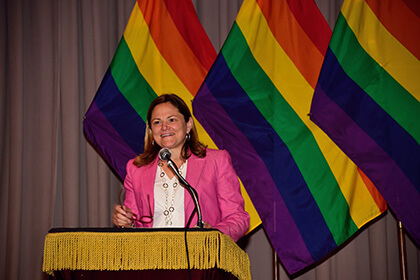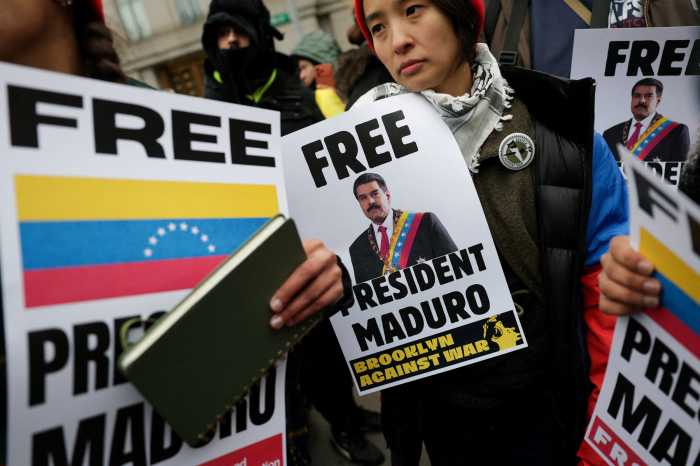Cathy Marino-Thomas, co-president of the Marriage Equality USA board, with her wife Sheila and their daughter Jackie, speaking to a crowd outside the Supreme Court on March 26. | DONNA ACETO
On the tenth anniversary of oral arguments in Lawrence v. Texas, the historic 2003 ruling that struck down laws against consensual gay sex, the US Supreme Court took up the contentious issue of same-sex marriage on March 26. Late last year, the high court granted the petition by the Official Proponents of California’s Proposition 8 that it review rulings by lower courts that the 2008 voter initiative violates the Equal Protection Clause of the 14th Amendment.
The written transcript and audio recording of the argument persuade this observer that, at least as of today, there is no majority on the court to rule one way or the other on the merits of this case. It is possible that the oral argument on March 27 on the constitutionality of the federal Defense of Marriage Act may cast further light on what will happen, since many of the underlying arguments are the same.
Charles Cooper appeared for the Prop 8 Proponents, Theodore Olson for the two same-sex couples who brought the challenge in San Francisco federal district court, and US Solicitor General Donald Verrilli, Jr., appeared as “amicus curiae” (friend of the court) to present the federal government’s position in support of the plaintiff same-sex couples.
Kennedy offers a way out for now –– the court deciding it should not have taken case
The court had allocated an hour for this argument, but eight of the justices were so fully engaged that they allowed the session to run for about 90 minutes. The extra time can largely be attributed to a question the court added when it granted the petition to review the case –– whether the Proponents, who intervened in the absence of California state officials defending Prop 8, had “standing” as required by longstanding precedent.
The arguments back and forth on this question signaled the importance some of the justices attached to it. Chief Justice John Roberts interrupted each of the lawyers at the outset of their presentations, cutting off their attempts to argue the merits by asking them first to address the standing issue. He didn’t redirect Cooper back to the merits until he had used up a substantial portion of his argument time on the standing question, and he also allowed that issue to eat up a significant portion of Olson’s time.
The Prop 8 Proponents relied on an advisory opinion from the California Supreme Court –– issued at the request of the US Ninth Circuit Court of Appeals –– that held as a matter of California law that initiative proponents have standing to defend their initiative if the state officials who would normally do so refuse. Their standing, Cooper argued, is not based on the “individualized injury” the Supreme Court normally requires, but instead on their designation as representatives of the state’s interest. This reasoning struck the Ninth Circuit as sufficient, but some of the justices had problems with it.
A pro-equality demonstrator outside the Supreme Court on March 26. | DONNA ACETO
Olson, arguing for the plaintiff couples, harped on the point that initiative proponents are not officers of the state, not accountable to the state or subject to its control, capable of running up large legal fees, and lacking in the fiduciary obligation public officials have to act in the public interest. Verrilli tried to evade the standing question, but when pushed to take a position said it was a “close question” but that “the better conclusion is that there’s not Article III standing.”
Some justices seemed sympathetic to Cooper’s argument that if the Proponents were not given standing, state officials who disliked a popular initiative would effectively have the power to veto it by refusing to defend it in court. This was an argument that impressed the Ninth Circuit.
It’s unclear if standing will be the basis for the court’s ruling. If a majority finds that the Proponents lacked standing to appeal the ruling, then the Ninth Circuit’s decision –– the outcome of the Proponents’ appeal of the district court decision striking down Prop 8 –– would be vacated. District Court Judge Vaughn Walker’s original ruling, then, would be left essentially as an unappealed trial court decision, with no value as precedent but binding on the parties to the case. Even though clerks in only two of the state’s 58 counties were sued, the entire state would almost certainly resume issuing marriage licenses to same-sex couples under this scenario.
An out based on standing may be a handy fallback position for the high court, particularly since Justice Anthony Kennedy, generally seen as the swing vote between the conservative and liberal wings, seemed to show the greatest problem making up his mind. At one point, he mused that perhaps the court should not have granted the petition to review the case. His questions and comments certainly revealed a sympathy with the plaintiff couples’ claim to the right to marry, particularly in emphasizing the potential harms Prop 8 inflicts on the thousands of children being raised by same-sex couples in California.
At the same time, he seemed bothered by the idea that a ruling on the merits could immediately put a stop to the unfolding political debate and impose same-sex marriage throughout the country. He was receptive to Cooper’s point that same-sex marriage is a new phenomenon, that its long-term impact on society is as yet unknown, and that a California voter might rationally conclude that Prop 8 would prevent potential harms while allowing the “experiment” to play out in other jurisdictions. This argument could pull him over to the conservatives, who seem prepared to rule that there is no constitutional right for same-sex couples to marry. But his reluctance to adopt that extreme view, which would be inconsistent with the underlying rationale of his opinion for the court in the Lawrence sodomy case, could make a dismissal without an opinion on the merits his most desired escape hatch.
Such a neat solution would avoid creating a national precedent while restoring the right to marry in California. The court could decide it had acted “improvidently” in earlier granting the Proponents’ petition to hear the case ––a device it has used in the past to avoid ruling on a contentious issue. Dismissing its earlier “writ of certiorari” would be the equivalent of a denial of review, which should not be construed as either approving or disapproving the Ninth Circuit ruling that affirmed Walker’s ruling against Prop 8. No national precedent would be established.
In Manhattan on March 24, Assemblyman Daniel O’Donnell, the legislative sponsor of the gay marriage law in New York, spoke to a crowd voicing support for Edie Windsor, the New York widow who is the plaintiff in the DOMA case being heard on March 27. | DONNA ACETO
One of the important issues in considering the case on the merits is whether the court should subject Prop 8 to “heightened scrutiny,” a standard under which its Proponents would lose if they could not demonstrate that the measure substantially advanced an important state interest. Justice Sonya Sotomayor asked Cooper, “Outside of the marriage context, can you think of any other rational basis, reason, for a state using sexual orientation as a factor in denying homosexuals benefits or imposing burdens on them? Is there any other rational decision-making that the government could make? Denying them a job, not granting them benefits of some sort, any other decision?”
Cooper’s response, a major concession, was, “Your Honor, I cannot. I do not have any — anything to offer you in that regard.” Instead, he argued that same-sex couples and different-sex couples are not “similarly situated” with respect to what he argues is one of the state’s important interests in marriage –– providing a vehicle for responsible procreation and child-rearing. In that way, he argued, Sotomayor’s question is not relevant to this case.
Cooper quickly recovered from his “concession” and argued that sexual orientation should not be deemed a suspect classification –– which would trigger heightened scrutiny of laws that treat gay and lesbian people differently. “The class itself is quite amorphous” and “defies consistent definition,” he argued.
During Olson’s argument on the merits, Justice Antonin Scalia signaled where he –– and most likely Justices Samuel Alito and Clarence Thomas –– would come down on the merits, by asking the plaintiffs’ attorney when the exclusion of same-sex couples from marriage became unconstitutional. Was it unconstitutional in 1791 when the Bill of Rights was adopted? In 1868, when the 14th Amendment went into effect? Scalia’s general position is that constitutional provisions are limited to the meaning they had when they were adopted.
Olson countered with well-worn examples. When did public school segregation become unconstitutional? The Congress that approved the 14th Amendment and sent it to the states for ratification maintained a segregated school system in the District of Columbia, and the Supreme Court approved the doctrine of “separate but equal” in the 1890s. Unless Scalia is ready to repudiate the 1954 Brown v. Board of Education decision, his historicism is blatantly inconsistent, but that doesn’t give him pause. He hectored Olson for a few minutes on the attorney’s inability to pinpoint the moment when same-sex marriage acquired the status of a constitutional right. Fortunately, Scalia’s view on this does not command a majority on the court, just the loyalty of Thomas and, usually, Alito.
Roberts has not been a consistent follower of that view, and Kennedy clearly repudiated it in Lawrence v. Texas. So the case won’t be decided on that basis.
None of the Justices seemed enamored with Solicitor General Verrilli’s argument that the court should adopt the Ninth Circuit’s rationale and hold that Proposition 8 was unconstitutional because California had already adopted family law policies that undercut all of the Proponents’ arguments for its enactment. This is the so-called eight-state solution, under which states that accord same-sex couples the legal rights of marriage under the guise of civil unions or domestic partnerships have no rational basis for withholding the status of marriage. Roberts and Justice Stephen Breyer shot holes through this argument, and all of the justices who commented on it saw it as odd that states that had not accorded any rights to same-sex couples would be left alone while those that had granted such rights would be found to violate the Constitution by not going “all the way.” Nobody seemed to favor this approach.
Roberts did not tip his hand on the merits during the questioning, and the four Democratic appointees appeared from their questions and comments to understand and endorse the argument that excluding same-sex couples from marriage might be insupportable as an equal protection matter, so as virtually all commentators have suggested in predicting the outcome, it may come down to Kennedy. What nobody had anticipated, however, was Kennedy’s suggestion that review should not have been granted, creating the possibility that the Ninth Circuit’s decision would stand without being endorsed or rejected by the high court.
That result would cabin the impact to California in the short term, but would also leave unquestioned by the Supreme Court the Ninth Circuit’s view that the arguments in support of Prop 8 are not substantial enough to justify rescinding the right to marry. This, in turn, would set up the likelihood that the Ninth Circuit might reverse trial court decisions from Nevada and Hawaii, now pending on review, concerning the right of same-sex couples to marry there. Reversals of district court rulings against the plaintiffs would quickly set up the potential for two new Supreme Court cases in which the states of Nevada and Hawaii would undoubtedly have standing should they choose to appeal.
A dismissal of the Prop 8 Proponents’ appeal without a ruling on the merits might buy the high court a bit more time, but one or two new same-sex marriage cases could well arrive on its doorstep in fairly short order.






































